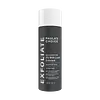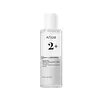Paula's Choice Skin Perfecting 2% BHA Liquid Exfoliant Versus Anua BHA 2% + Ceramides Gentle Exfoliating Toner
What's inside
What's inside
 Key Ingredients
Key Ingredients

 Benefits
Benefits

 Concerns
Concerns

 Ingredients Side-by-side
Ingredients Side-by-side

Water
Skin ConditioningDipropylene Glycol
Humectant1,2-Hexanediol
Skin ConditioningSalicylic Acid
MaskingC12-14 Alketh-12
EmulsifyingOctyldodeceth-16
EmulsifyingPentylene Glycol
Skin ConditioningSalix Alba Bark Extract
AstringentMelaleuca Alternifolia Leaf Extract
PerfumingFicus Carica Fruit Extract
HumectantCentella Asiatica Extract
CleansingOenothera Biennis Flower Extract
AstringentUlmus Davidiana Root Extract
Skin ConditioningPinus Palustris Leaf Extract
TonicPueraria Lobata Root Extract
HumectantHydrogenated Lecithin
EmulsifyingSodium Hyaluronate
HumectantSodium Citrate
BufferingButylene Glycol
HumectantGlycerin
HumectantEthylhexylglycerin
Skin ConditioningCitric Acid
BufferingXanthan Gum
EmulsifyingDisodium EDTA
Panthenol
Skin ConditioningTocopherol
AntioxidantCeramide NP
Skin ConditioningZinc Sulfate
AntimicrobialTriethylhexanoin
MaskingCholesterol
EmollientGlyceryl Stearate
EmollientHydrogenated Polydecene
EmollientCetearyl Alcohol
EmollientPotassium C11-15 Alkyl Phosphate
Ceramide Ng
Skin ConditioningPhytosphingosine
Skin ConditioningDimethicone
EmollientCeramide As
Skin ConditioningCeramide AP
Skin ConditioningCeramide Ns
Skin ConditioningDimethylsilanol Hyaluronate
HumectantHydrolyzed Sodium Hyaluronate
Skin ConditioningHydrolyzed Hyaluronic Acid
HumectantPotassium Hyaluronate
Skin ConditioningHyaluronic Acid
HumectantSodium Hyaluronate Crosspolymer
HumectantHydroxypropyltrimonium Hyaluronate
Sodium Hyaluronate Dimethylsilanol
HumectantSodium Acetylated Hyaluronate
HumectantGlycine
BufferingGlutamic Acid
HumectantGlutamine
Skin ConditioningLysine
Skin ConditioningLeucine
Skin ConditioningMethionine
Skin ConditioningValine
MaskingSerine
MaskingCysteine
AntioxidantCitrulline
Skin ConditioningAsparagine
MaskingAspartic Acid
MaskingIsoleucine
Skin ConditioningAlanine
MaskingArginine
MaskingOrnithine
Skin ConditioningTaurine
BufferingTyrosine
MaskingThreonine
Tryptophan
MaskingPhenylalanine
MaskingProline
Skin ConditioningHistidine
HumectantCeramide EOP
Skin ConditioningWater, Dipropylene Glycol, 1,2-Hexanediol, Salicylic Acid, C12-14 Alketh-12, Octyldodeceth-16, Pentylene Glycol, Salix Alba Bark Extract, Melaleuca Alternifolia Leaf Extract, Ficus Carica Fruit Extract, Centella Asiatica Extract, Oenothera Biennis Flower Extract, Ulmus Davidiana Root Extract, Pinus Palustris Leaf Extract, Pueraria Lobata Root Extract, Hydrogenated Lecithin, Sodium Hyaluronate, Sodium Citrate, Butylene Glycol, Glycerin, Ethylhexylglycerin, Citric Acid, Xanthan Gum, Disodium EDTA, Panthenol, Tocopherol, Ceramide NP, Zinc Sulfate, Triethylhexanoin, Cholesterol, Glyceryl Stearate, Hydrogenated Polydecene, Cetearyl Alcohol, Potassium C11-15 Alkyl Phosphate, Ceramide Ng, Phytosphingosine, Dimethicone, Ceramide As, Ceramide AP, Ceramide Ns, Dimethylsilanol Hyaluronate, Hydrolyzed Sodium Hyaluronate, Hydrolyzed Hyaluronic Acid, Potassium Hyaluronate, Hyaluronic Acid, Sodium Hyaluronate Crosspolymer, Hydroxypropyltrimonium Hyaluronate, Sodium Hyaluronate Dimethylsilanol, Sodium Acetylated Hyaluronate, Glycine, Glutamic Acid, Glutamine, Lysine, Leucine, Methionine, Valine, Serine, Cysteine, Citrulline, Asparagine, Aspartic Acid, Isoleucine, Alanine, Arginine, Ornithine, Taurine, Tyrosine, Threonine, Tryptophan, Phenylalanine, Proline, Histidine, Ceramide EOP
 Reviews
Reviews

Ingredients Explained
These ingredients are found in both products.
Ingredients higher up in an ingredient list are typically present in a larger amount.
Butylene Glycol (or BG) is used within cosmetic products for a few different reasons:
Overall, Butylene Glycol is a safe and well-rounded ingredient that works well with other ingredients.
Though this ingredient works well with most skin types, some people with sensitive skin may experience a reaction such as allergic rashes, closed comedones, or itchiness.
Learn more about Butylene GlycolSalicylic Acid (also known as beta hydroxy acid or BHA) is a well-known ingredient for treating skin that struggles with acne and clogged pores. It exfoliates both the skin's surface and deep within the pores to help clear out buildup, control oil, and reduce inflammation.
Unlike AHAs (alpha hydroxy acids), salicylic acid is oil-soluble. This allows it to penetrate into pores which makes it especially effective for treating blackheads and preventing future breakouts.
Salicylic acid is also known for its soothing properties. It has a similar structure to aspirin and can calm inflamed or irritated skin, making it a good option for acne-prone skin that is also sensitive.
Concentrations of 0.5-2% are recognized by the U.S. FDA as an over-the-counter topical acne product.
It can cause irritation and/or dryness if one's skin already has a compromised moisture barrier, so it's best to focus on repairing that before introducing this ingredient into your routine.
While salicylic acid does not increase sun sensitivity, it’s still important to wear sunscreen daily to protect your skin.
If you are looking for the ingredient called BHA or Butylated Hydroxyanisole, click here.
Learn more about Salicylic AcidWater. It's the most common cosmetic ingredient of all. You'll usually see it at the top of ingredient lists, meaning that it makes up the largest part of the product.
So why is it so popular? Water most often acts as a solvent - this means that it helps dissolve other ingredients into the formulation.
You'll also recognize water as that liquid we all need to stay alive. If you see this, drink a glass of water. Stay hydrated!
Learn more about Water